


Introduction to Liverworts
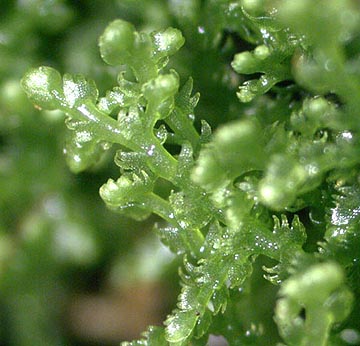 |
| Lepidozia reptans |
LIVERWORT MOPHOLOGY AND DEVELOPMENT
Liverworts come in two very distinct forms: leafy and thalloid. Leafy liverworts are obviously, leafy, and look very much like the mosses. They are most easily distinguished from the mosses by their leaf arrangement. Leafy liverworts have leaves that are arranged in two or three rows while the leaves in mosses are spirally arranged. Thalloid liverworts, on the other hand, do not look anything like mosses. They do not have stems or leaves; instead their main body is flat, like a green pancake. It is easiest to tell liverworts apart based on the appearance of the leafy part (the dominant, gametophytic generation); most liverwort sporophytes look very similar.
THE GAMETOPHYTE OF THALLOID LIVERWORTS
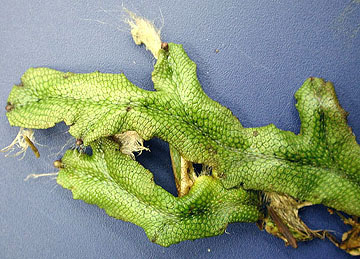 |
| Conocephalum conicum - a thalloid liverwort |
The tissue within the thallus can be quite differentiated, as in the Marchantiales, or can have little differentiation, as in the Metzgeriales. These relatively undifferentiated thalli are only one or two cell layers thick. Marchantiales typically have thalli that are composed of multiple cell layers.
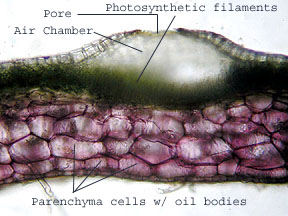 |
| Conocephalum conicum - thallus cross section |
Liverworts have unicellular rhizoids that are located on the ventral (bottom) side of the gametophyte. Rhizoids look like roots, but do not absorb water or nutrients. Instead, they attach the plants to their substrate and help with external water retention and conduction. Some thalloid liverworts have scales associated with their rhizoids. These scales can be easily distinguished from the rhizoids because they are multicellular and are usually pigmented.
Some liverworts reproduce asexually by producing gemmae in gemmae cups. Gemmae are vegetative diaspores that can germinate to form a new plant that is genetically identical to the parent plant. The gemmae are dispersed when water droplets fall into the splash cups; the shape of the cup makes the water splash out, and it takes some gemmae with it, carrying them far away from the parent plant.
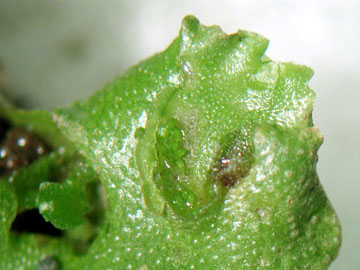 |
| Lunularia gemmae cup |
THE GAMETOPHYTE OF LEAFY LIVERWORTS
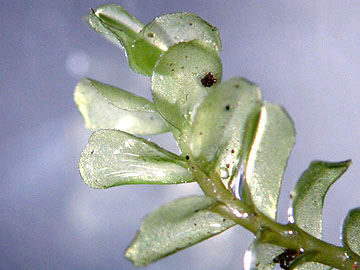 |
| Plagiochila - a leafy liverwort |
In general, the gametophytes of leafy liverworts are very small, with leaves that are only about 1 mm long. Although leafy liverworts look very much like mosses, they can be distinguished from mosses by their leaf arrangement. Leafy liverworts always have two lateral rows of leaves, and sometimes a row of leaves on the ventral side (bottom) of the stem, which are called underleaves. Another distinguishing feature of liverwort leaves is the presence of lobes. Lobed leaves look like they have an extra flap of tissue at the base; the lobe is like the thumb of a mitten.
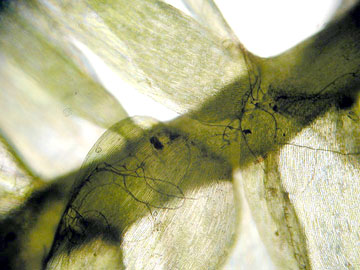 |
| A leafy shoot of Pseudotaxiphyllum elegans - a moss - under the microscope. The leaves have a whorled arrangement. |
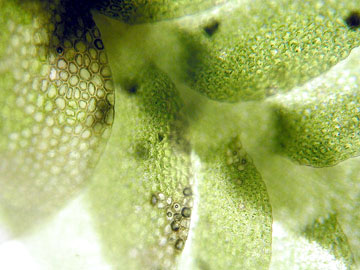 |
| A leafy shoot of a leafy liverwort. The leaves are arranged in two rows and sometimes with a third row on the underside of the stem (not shown from this angle). |
Like the mosses, liverwort leaves are only one cell layer thick. These cells are usually isodiametric, meaning, the cell is as long as it is wide.
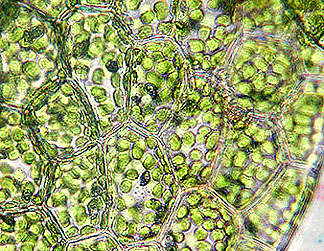 |
| Liverwort isodiametric cells with complex oil bodies |
The stem of leafy liverworts is usually green. Unlike the mosses, the liverworts do not have any specialized tissue for internal water or nutrient conduction in the stem.
The rhizoids of leafy liverworts are similar to those found in the thalloid liverworts. They are unicellular and perform the same function as a rhizoid found in any other bryophyte.
THE SPOROPHYTE OF THE LIVERWORTS
Liverwort sporophytes seem to look similar to those found in the mosses, but they have quite a number of developmental and anatomical differences. One such difference is that the sporangium in liverworts matures before the seta elongates, which is opposite to the mosses. Once the sporangium matures, spore dispersal in the liverworts is abrupt, not prolonged like in the mosses. Spores are expelled out of the sporangium all at once. After the seta elongates the sporangium splits open by four longitudinal lines of dehiscence. Another unique feature of liverwort spore dispersal is the presence of elaters, which contract and expand according to humidity to help propel spores. Note that after spore dispersal liverwort sporangia quickly wither away, unlike moss sporangia, which can persist for over a year. The calyptra in the liverworts is shed when the seta elongates, and is left at the base of the sporophyte.


